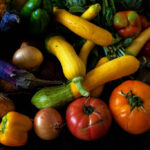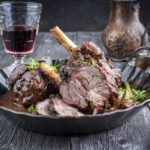I loves me wine. But even among “wine-lovers” there is so much confusion out there! There needn’t be, really! For me, there are just two major, overarching thoughts that come to my mind whenever wine is discussed:
1) Wine is for food. Let me say it again, a little louder: WINE IS FOR FOOD! With rare exceptions, wine gives the most pleasure when it’s drunk, nicely matched, in the presence of pleasurable food. This American habit we have of a glass of red wine as a “cocktail,” all by its lonesome (usually all by its loathsome), is not a habit you’ll see in any of the wine-drinking nations of Europe.
2) As I’ve tracked wine-with-food over the decades, I’ve found that certain kinds of wines are generally difficult with food (unless you’re lucky, or really talented at menu selection). And, I’ve found the opposite: certain kinds of wines are really easy to match with food!
Let’s call spades spades. California Syrah is always going to need a lot of care in gastronomic marriage-making. But as the famous English wine writer Hugh Johnson once proclaimed as I pulled out a dry German Riesling for lunch (and he didn’t know the menu!)…”Ah!! The banker!!” Meaning you can bank on this wine to go with almost anything.
Many wine-drinkers in the U.S., intoxicated with the variety of global wines available to us, carry around the fantasy that every wine has a waiting food soul-mate somewhere! And we assiduously go at the global match game. We struggle and struggle with wine selection at the table to get it right, to satisfy all the lost vinous souls. Unfortunately…as it is in life…only certain kinds of wannabes (people or wines) have their soul-mates. For many wines, it’s a lifetime of bachelorhood (or, from my point of view, should be!)
But I’ve got a better plan. Rather than surveying the whole international wine constellation every time a wine is needed for, say, fried chicken…why don’t we simply train ourselves to recognize “wine groups” that always go well with food? Like five or ten of them? Doesn’t that make life a lot easier?
There’ll be a lot more on this later on. Before 2012 is out, I will be selling wines that fit into ten “food-loving” categories…and, at that, ten categories not so easy to find in the U.S. I’ll be launching my new ROSENGARTEN REPORT in 2014, which will give all wines a rating for flexibility with food.
But for now, on this My Five day…
Here are my five most reliable kinds of wine to go with your dinner!
1) Dry Sherry
For some, this seems like an oxymoron. But to me, it is the Sherry-challenged who seem like oxymorons…minus the oxy! (OK, way too harsh, but couldn’t resist the word play!) Now, it is true that most of the Sherry message we get in America does concern a sweet, brown, mediocre drink that you would only want to share with Aunt Edna at the vicarage. But that’s just the super old-fashioned Sherry (of which there are actually some superior examples). Most of the Sherry-drinking in Spain (and remember that Spain is the only country I mean when I say “Sherry”)…concerns bone-dry, super-crisp Sherry, that looks exactly like a young white wine in the glass. The Spaniards like to keep it super-cold, usually in half-bottles…and use many crackling cold half-bottles of it to while away an afternoon or evening of shellfish, and other treats. I also love it with salumi (Iberico ham, of course!), hard cheese, anchovies, almonds, red peppers, seafood dishes (particularly pasta)…millions of things. I often find it easier to match with, say, a generic main course like roast chicken than “regular” white wines. It is time for a Sherry boom in America! To make sure you have the dry stuff…look for “fino” or “manzanilla” on the label.
2) Dry Riesling
My own true love. Riesling is another terribly misunderstood wine. After World War II, the shattered Germans needed to find a good overseas market for their product…so they started shipping cheap, sweet Riesling (like Liebfraumilch) to sweet-tooth customers in the U.S. and England. It was a great temporary fix. But that particular band-aid finally came off: several generations of Yanks and Brits now believe that German Riesling is a crappy sweet thing, and are adverse to the GREAT dry wine coming out of Germany! In fact, about 70% of the Riesling produced in Germany today is dry…and, say, a fourtop of businessmen at lunch in Frankfurt would never drink anything other than the dry stuff with their meal! The key word is “trocken”…no matter what else is on the label, if a German bottle indicates “trocken”…it’s dry. And my oh my…is it ever widely flexible with food. It has relatively low alcohol (dry Rieslings are usually 11-12% or so), no interfering oak, otherwordly acidity to cut through food. The flavors are fruity in youth, but turn minerally within a few years—the perfect accompaniment to savory food. Dry German Riesling can be served either as a tart “similarity” match to light, acidic foods, like salad or ceviche…or as a buzz-saw cut-through for rich and fatty foods, like roast pork. This kind of wine has got the menu covered! Now, I do focus on dry Riesling from Germany, because I think it the most food-friendly…but dry Riesling from other places is also effective. Alsace and Austria both produce gorgeous dry Rieslings, though often a little more forceful (and trickier for food) than the German ones. New World ones are all over the map, food-wise…but my absolute favorite New World place for dry Riesling is four hours south of Perth, in the Great Southern Region of Western Australia, a still-obscure little micro-climate called Frankland River.
3) Champagne with Age
For starters, I’m being quite specific here…when I say Champagne, I mean sparkling wine made in the Champagne method in the Champagne region of France. It is the only legal definition of “Champagne” in Europe…but producers ’round the world (including some in California) abuse the word, and call their inferior bubblies “Champagne!” Beyond the geography issues…I’m also calling for Champagne with some age; at this moment, for wide-ranging food flexibility, I’d only consider Champagne from 2004 or before. Why? Young Champagne (like a lot of the basic Bruts out there) is dominated by young fruit, on nose and palate. I don’t dislike this stuff…but it’s not regularly lock-and-key with food, as older Champagnes are. This type of Chardonnay-Pinot Noir-Pinot Meunier fruit often gets in the way. Older Champagnes usually feature a more savory grilled-bread/yeasty quality, great with food. I like ’em dry, in general…but, with age, Champagne usually dries out a bit more, all to the good. Try a fruity young Taittinger, or Moet & Chandon, with caviar: that match ain’t going anywhere. But try the same caviar with, say, a 1985 Charles Heidsieck…oh baby! That’s what I’m talking ’bout! And with all salty foods (ham, smoked salmon). With fish (salmon is insane with yeasty-tasting Champagne), even fish in cream sauce. Fried foods–from shrimp tempura to Southern Fried Chicken! And sushi! And…and…and…Of course, if you can find a Champagne house that makes wine in a super-crisp, elegant style to begin with…you’re in luck. Tippy top of that pyramid? The super-luxury house of Salon. Pay a fortune, taste their 1996 (one of my favorite Champagne vintages)…and ye shall see the light.
4) Young Beaujolais
What I have to say about Beaujolais and food is kind of embarrassing, in many regards. First of all, Beaujolais is the wine that wine snobs love to hate; “it’s so simple and grapy,” they say. Well, they are right…it is! In the way that a GREAT bistro wine in France is, right alongside your garlic sausage, or grilled loup de mer, or cassoulet…or almost anything from the French canon! Get over yourself! Young Beaujolais tastes like a party in a bottle: strawberries, raspberries, bananas. What’s wrong wi’ dat? Now, I really push the envelope when I say: the “better” the Beaujolais is…the less flexible it is for food! Some of the more open-minded snobs will now deign to drink the more expensive Beaujolais from one of the 11 famous villages (known as “crus”) that put the village names on the labels (Fleurie, Julienas, Morgon, etc.) These bottles do not blare “Beaujolais” on their labels. Fine. Save them for special gastronomic circumstances. What I like to drink with food is very young Beaujolais (2010 or 2011 right now) that calls itself “Beaujolais”…either Beaujolais-Villages, or Beaujolais, or even…embarrassment of embarrassments!…Beaujolais Nouveau, which has given the region a bad name among wine snobs, but is so PERFECT with most foods from November through the summer. Just remember: the operative fantasy image is sitting in a bistro in Lyon, not dining at Daniel in New York, or Taillevent in Paris! Party on, mes amis!
5) Old Rioja
Let’s say that red wine has two gastronomic sides worth caring about: the fruity-but-balanced side (see Beaujolais above), and the more regal, complex, polished old-wine side. Note that neither feature the harsh tannin American wine-lovers have been deceived into liking (actual quote from a Californian: “Dave, I know a wine is good…when it hurts!”). I generally do not like expensive California red wine with food. But when I do want to burn a few bucks on red at the table…I turn to aged European red wines…be they Bordeaux, or Burgundy, or Rhônes, or Brunellos, or Piedmontese Nebbiolos…or aged red Rioja! In fact, of all these regal wines…aged red Rioja may be the one that has brought me the highest percentage of matching success at the table. As these wines age, tannin recedes mightily, leaving suave, velvety, elegant wines with ineffable and mysterious aromas of leather, chocolate, forest floor. It is my favorite kind of red wine for rare red meat…and a number of other meaty delights as well (avoid sweetness and spice). Old red Rioja has several other advantages. It starts tasting like an “old wine” in fewer years than, say, Bordeaux…so right now the great Rioja vintage of 2001 is starting to drink well, whereas I’m still waiting for 90’s from Bordeaux to come around. Additionally, old Rioja (like the 2001) will cost you nothing next to old-tasting Bordeaux, Burgundy, etc. The one caveat is this: a lot of Rioja producers, over the last few decades, have started pumping out a sturdier, more international style of red Rioja. Avoid these. Go with the tried-and-true traditionalists: Lopez de Heredia, Murrieta, CUNE, La Rioja Alta. Buen provecho!
Photos Via: Danielle Lieberman








